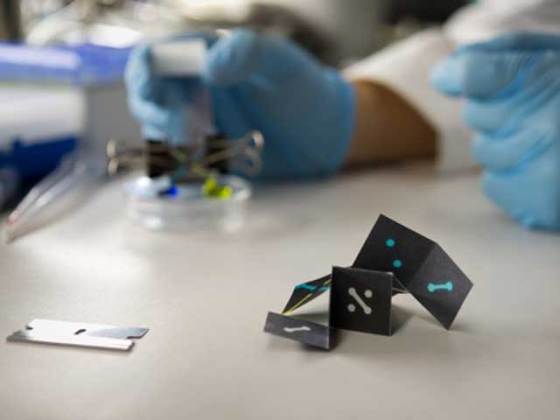oPAD – origami-inspired paper sensor
 Inspired by the paper-folding art of origami, chemists at The University of Texas at Austin have developed origami Paper Analytical Device (oPAD) – a low-cost 3D paper sensor that may be able to test for diseases such as malaria and HIV. It can be produced in less than a minute without any tools or special alignment techniques for a price lower than 10 cents per piece.
Inspired by the paper-folding art of origami, chemists at The University of Texas at Austin have developed origami Paper Analytical Device (oPAD) – a low-cost 3D paper sensor that may be able to test for diseases such as malaria and HIV. It can be produced in less than a minute without any tools or special alignment techniques for a price lower than 10 cents per piece.
oPad was developed by Richard Crooks, the Robert A. Welch Professor of Chemistry, and doctoral student Hong Liu, who was inspired by a pioneering paper by Harvard University chemist George Whitesides. Whitesides was the first to build a three-dimensional “microfluidic” paper sensor that could test for biological targets. Unfortunately, Whiteshades sensor was expensive and time-consuming to make, and was constructed in a way that limited its uses.
“They had to pattern several pieces of paper using photolithography, cut them with lasers, and then tape them together with two-sided tape”, said Liu, a member of Crooks’ group. “When I read the paper, I remembered when I was a child growing up in China, and our teacher taught us origami. I realized it didn’t have to be so difficult. It can be very easy. Just fold the paper, and then apply pressure.”
Within a few weeks of experiments, Liu had fabricated oPAD on one simple sheet using photolithography or simply an office printer they have in the lab. A hydrophobic material is laid down into tiny etches on chromatography paper in order to channel the examined sample that’s being tested into the areas on the paper where test reagents have been embedded.
University of Texas at Austin researchers said that the principles underlying the sensor, which they’ve successfully tested on glucose and a common protein, can be compared to use of the home pregnancy test. Biomarkers embedded into oPAD react accordingly by turning into a specific color, or becoming fluorescent under a UV light.
“Biomarkers for all kinds of diseases already exist”, said Crooks. “Basically you spot-test reagents for these markers on these paper fluidics. They’re entrapped there. Then you introduce your sample. At the end you unfold this piece of paper, and if it’s one color, you’ve got a problem, and if not, then you’re probably OK.”
Crooks and Liu have also engineered a way to add a simple battery to their sensor so that it can run tests that require power, and they estimate that such a low power battery wouldn’t add more than few cents to the cost. Their prototype uses aluminum foil and looks for glucose in urine.
“Anybody can fold them up”, said Crooks. “You don’t need a specialist, so you could easily imagine an NGO with some volunteers folding these things up and passing them out. They’re easy to produce, so the production could be shifted to the clientele as well. They don’t need to be made in the developed world.”
For more information, read the paper publishes in the Analytical Chemistry: “Paper-Based Electrochemical Sensing Platform with Integral Battery and Electrochromic Read-Out”.










Leave your response!